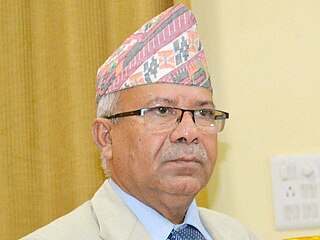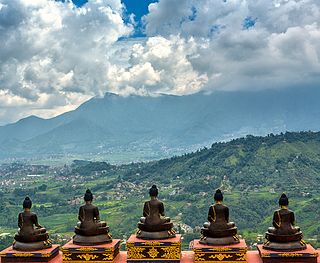
Pushpa Kamal Dahal, alias Prachanda, is a Nepalese politician currently serving as the Prime Minister of Nepal. He previously held the prime ministerial post from 2008 to 2009 as the first prime minister of the Federal Democratic Republic of Nepal, and again from 2016 to 2017. He was elected as prime minister for the third time in 2022, following that year's elections.

Sher Bahadur Deuba is a Nepali politician and former prime minister of Nepal. He has also been serving as the president of the Nepali Congress since 2016. Deuba has served five terms as prime minister and is the Member of Parliament for the parliamentary constituency of Dadeldhura 1.

Nepal Ratna Girija Prasad Koirala, affectionately known as Girija Babu, was a Nepalese politician. He headed the Nepali Congress and served as the Prime Minister of Nepal on four occasions, including from 1991 to 1994, 1998 to 1999, 2000 to 2001, and 2006 to 2008. He was the Acting Head of State of Nepal between January 2007 and July 2008 as the country transitioned from a monarchy to a republic.

The Nepal Workers Peasants Party (NWPP), also known as the Nepal Workers' and Peasants' Party and the Nepal Majdoor Kisan Party, is a communist political party in Nepal. The party was founded on 23 January 1975 by Narayan Man Bijukchhe and draws most of its support from Bhaktapur. The party is sympathetic to the Workers' Party of Korea and has declared Juche to be a "directional ideology".

Madhav Kumar Nepal, is a Nepalese politician and former Prime Minister of Nepal. He served as Prime Minister of Nepal from 25 May 2009 to 6 February 2011 for nearly two years.

Constitution of Nepal 2015 is the present governing Constitution of Nepal. Nepal is governed according to the Constitution which came into effect on 20 September 2015, replacing the Interim Constitution of 2007. The constitution of Nepal is divided into 35 parts, 308 Articles and 9 Schedules.

Sushil Prasad Koirala was a Nepalese politician and the Prime Minister of Nepal from 11 February 2014 to 10 October 2015. He was also President of the Nepali Congress from 2010 to 2016, having earlier served under various capacities in the party.

Janakpurdham or Janakpur is a sub-metropolitan city in Dhanusha district, Madhesh Province, Nepal. The city is a hub for religious and cultural tourism. A headquarter of Dhanusha district, Janakpur is also the capital for Madhesh Province.

Arjun Narasingha K.C., also known as ANKC, is a Nepali politician and former professor, currently serving as a Member of Parliament (MP) from Nuwakot representing the Nepali Congress Party. KC has served as minister five times in different coalition governments holding Education, Health, Housing & Physical Planning and Urban Development portfolios. He most recently served as the Minister of Urban Development in the Second Dahal Cabinet from 2016 to 2017. KC has been elected to the national legislature a total of four times from his constituency of Nuwakot.
Nabindra Raj Joshi was a Nepali politician and former minister for industry. Joshi joined politics as a student, becoming the general secretary of Nepal Students Union in 1986. After the re-establishment of democracy, he was elected deputy mayor of Kathmandu, serving from 1992 to 1997. After the 2006 revolution, he was twice elected to the constituent assembly, in 2008 and 2013. He was the minister of industry from 2016 to 2017 in the coalition government of Communist Party of Nepal and Nepali Congress under the leadership of Pushpa Kamal Dahal. In the 2017 general election, he lost to Jeevan Ram Shrestha of CPN UML whom he had defeated in the previous elections.
Rajendra KC is a leader of Nepali Congress party and newly elected member of Constituent Assembly in Nepal. KC defeated UCPN Maoist Chairman Prachanda in Kathmandu Constituency no ten.
Narahari Acharya, a central member of Nepali Congress, assumed the post of the Minister of Law, Justice, Constituent Assembly, Parliamentary Affairs and Peace and Reconstruction on 25 February 2014 under Sushil Koirala-led government.
Sanjay Man Shrestha is a Nepali singer and musician. In 1992, Shrestha founded the pop music band Crossroads, which fused western-style singing and traditional Nepali instrumental music. Shrestha produced several popular songs, including the hit Maya Meri Maya.

Gokarneshwor is a municipality in Kathmandu District in the Bagmati Province of Nepal that was established on 2 December 2014 by merging the former Village development committees Sundarijal, Nayapati, Baluwa, Jorpati and Gokarna. The office of the municipality is that of the former Jorpati village development committee. The river Bagmati has its origin as the name Bagh Dwar situated in the middle of the Shivapuri jungle in this municipality.

Kageshwori-Manohara is a municipality in Kathmandu District in the Bagmati Province of Nepal that was established on 2 December 2014 by merging the former Village development committees of Aalapot, Bhadrabas, Danchhi, Gagalphedi, Gothatar and Mulpani. The office of the municipality is in Thali Danchhi in Ward No. 5.

Tokha is a municipality in Kathmandu District in Bagmati Province of Nepal that was established on 2 December 2014 by merging the former Village development committees Dhapasi, Jhor Mahankal, Gongabu, Tokha Chandeshwari and Tokha Saraswati on 2 December 2014. The municipality derives its name from the historical town of Tokha.

Nagarjun is a municipality in Kathmandu District in Bagmati Province of Nepal. It was formed on 2 December 2014 by merging the former VDCs of Bhimdhunga, Ichangu Narayan, Ramkot, Syuchatar and Sitapaila. The office of the municipality is located at Harisiddhi, Sitapaila. There are ten wards in the municipality.

The Autonomous Nepalese Provinces were formed on 20 September 2015 in accordance with Schedule 4 of the Constitution of Nepal. The seven provinces were formed by grouping the existing districts. The current system of seven provinces replaced an earlier system where Nepal was divided into 14 administrative zones which were grouped into five development regions.

Bagmati Province is one of the seven provinces of Nepal established by the constitution of Nepal. Bagmati is Nepal's second-most populous province and fifth largest province by area. It is bordered by Tibet Autonomous Region of China to the north, Gandaki Province to the west, Koshi Province to the east, Madhesh Province and the Indian state of Bihar to the south. With Hetauda as its provincial headquarters, the province is also the home to the country's capital Kathmandu, is mostly hilly and mountainous, and hosts mountain peaks including Gaurishankar, Langtang, Jugal, and Ganesh.

Gandaki Province ), is one of the seven federal provinces established by the current constitution of Nepal which was promulgated on 20 September 2015. Pokhara is the province's capital city. It borders the Tibet Autonomous Region in Southwest China to the north, Bagmati Province to the east, Karnali Province to the west, and Lumbini Province and Bihar of India to the south. The total area of the province is 21,504 km2 - constituting 14.57% of Nepal's total area. According to the latest census, the population of the province was 2,479,745. The newly elected Provincial Assembly adopted Gandaki Province as the permanent name by replacing its initial name Province No. 4 in July 2018. Surendra Raj Pandey is the present chief minister of Gandaki Province.



















